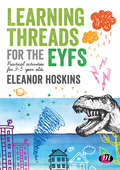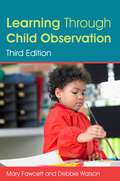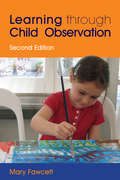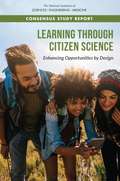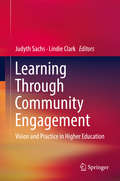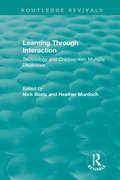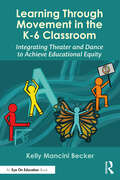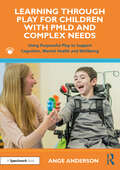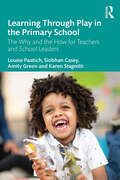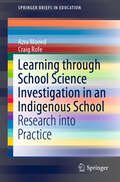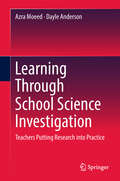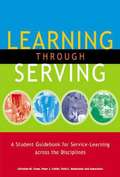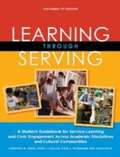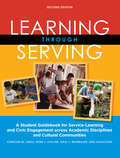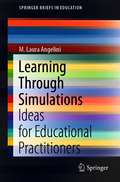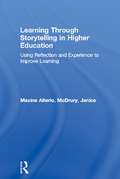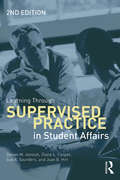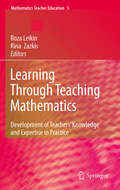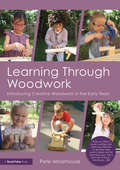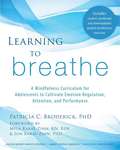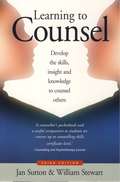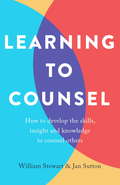- Table View
- List View
Learning Threads for the EYFS: Practical activities for 3-5 year olds
by Eleanor HoskinsThis text offers practical ideas and guidance for activities through which all areas of the EYFS can be delivered. Each chapter presents a different Learning Thread. For each thread, the author details a number of activities, lists effective resources and most importantly explores opportunities for child initiated learning. Ideas for role play areas and further scope for learning in each thread are also covered. The text demonstrates how these activities can be used whilst planning continuous provision. This book also: Demonstrates how activities link to the EYFS framework directly Offers practical guidance on what to do in settings and with children to enhance their learning Shows how learning can be 'blended' as all learning threads offer links across the prime and specific areas.
Learning Through Child Observation, Third Edition
by Mary Fawcett Debbie WatsonThis fully updated third edition of Learning Through Child Observation is a handbook for professionals working in, or students preparing to work in, children's services. This accessible text examines the value of observation, its use in assessment and the practical aspects and methods of observational study. The authors focus on the importance of fully recognising the child's developmental and emotional state when intervening, and the need to see children 'holistically' and as unique individuals within the wider context of the family and community. This new edition reflects updates to policy and practice and further develops the critical perspective on contemporary thinking about childhood and observational methods. This edition has also expanded its focus to include observation of primary-aged children. A popular text, it will appeal to students and professionals in all children's services, whether in pre-school, schools, social care, mental health or health settings.
Learning Through Child Observation: Second Edition
by Mary FawcettThis fully-updated second edition of Learning Through Child Observation is a handbook for professionals working in, or students preparing to work in, children's services. This accessible text examines the value of observation, its use in assessment and the practical aspects and methods of observational study. The author focuses on the importance of fully recognising the child's developmental and emotional state when intervening, and the need to see children `holistically' and as unique individuals within the wider context of the family and community. New chapters include Views of Children and Childhood, which draws on European educational and sociological perspectives and highlights the contrasting views of children, and The 'Hundred Languages of Children', which considers the place of creative engagement and multiple forms of expression by children. With new material and updated chapters, this second edition of a popular text will appeal to students and professionals in all children's services, whether in pre-school, schools, social care, mental health or health settings.
Learning Through Citizen Science: Enhancing Opportunities By Design
by Engineering Medicine National Academies of SciencesIn the last twenty years, citizen science has blossomed as a way to engage a broad range of individuals in doing science. Citizen science projects focus on, but are not limited to, nonscientists participating in the processes of scientific research, with the intended goal of advancing and using scientific knowledge. A rich range of projects extend this focus in myriad directions, and the boundaries of citizen science as a field are not clearly delineated. Citizen science involves a growing community of professional practitioners, participants, and stakeholders, and a thriving collection of projects. While citizen science is often recognized for its potential to engage the public in science, it is also uniquely positioned to support and extend participants’ learning in science. Contemporary understandings of science learning continue to advance. Indeed, modern theories of learning recognize that science learning is complex and multifaceted. Learning is affected by factors that are individual, social, cultural, and institutional, and learning occurs in virtually any context and at every age. Current understandings of science learning also suggest that science learning extends well beyond content knowledge in a domain to include understanding of the nature and methods of science. Learning Through Citizen Science: Enhancing Opportunities by Design discusses the potential of citizen science to support science learning and identifies promising practices and programs that exemplify the promising practices. This report also lays out a research agenda that can fill gaps in the current understanding of how citizen science can support science learning and enhance science education.
Learning Through Community Engagement
by Judyth Sachs Lindie ClarkThis book charts the development of a whole-institution approach to university-community engagement at a modern Australian university, highlighting the pivotal role that curriculum renewal can play in organizational transformation. It describes how Macquarie University's PACE (Professional and Community Engagement) program developed and fostered a culture of learning that has been at the center of academic renewal, differentiation, and institutional change. It details the development of the PACE pedagogical model, the establishment of the network of stakeholder relationships which underpin it, and the embedding of the model across the whole institution. Authored by those directly involved in the change project, this book tells the story of PACE, its achievements, challenges, success factors and future directions. A series of dovetailing contributions by leading international scholars of university-community engagement set the PACE story in its global context. This book adds to the scholarship of learning through community engagement, provides international perspectives on trends and issues in university-community engagement, contributes to a broader understanding of the practice and pedagogy of community engagement, and discusses the challenges and opportunities of implementing and sustaining change in the higher education sector.
Learning Through Interaction: Technology and Children with Multiple Disabilities (Routledge Revivals)
by Nick Bozic and Heather MurdochPublished in 1996, this book is written for teachers and other professionals who work with children with multiple disabilities. It explores and suggests ways of working with different forms of technology such as microcomputers, communications aids, multi-sensory equipment, mobility aids, and others, with children who have more than one disability. In keeping with the general aims on this book, much attention is focused on the practitioner’s role in the successful use of technology.
Learning Through Movement in the K-6 Classroom: Integrating Theater and Dance to Achieve Educational Equity
by Kelly Mancini BeckerThis book offers a creative and practical guide for K-6 teachers on how to effectively integrate movement into the curriculum to increase student engagement, deepen learning, improve retention, and get kids moving during the school day. Chapters offer concrete ideas for integrating creative movement and theater into subjects such as math, science, literacy, and social studies. Drawing on two decades of experience, Dr. Becker outlines key skills, offers rich examples, and provides adaptable and flexible classroom tested lesson plans that align with Common Core Standards, the NGSS, C3 Social Studies Standards, and the National Core Arts Standards. Activities are grounded in arts integration, which is steadily gaining interest in school reform as an effective teaching strategy that increases student outcomes academically and socially—particularly effective for students who have traditionally been marginalized. This book will benefit practicing educators who want to invigorate their practice, preservice teachers who want to expand their toolkit, and school leaders looking to employ policies that support movement and arts during the school day. Jump in and get your kids Learning Through Movement and see how active and engaging learning can be!
Learning Through Movement in the K-6 Classroom: Integrating Theater and Dance to Achieve Educational Equity
by Kelly Mancini BeckerThis book offers a creative and practical guide for K-6 teachers on how to effectively integrate movement into the curriculum to increase student engagement, deepen learning, improve retention, and get kids moving during the school day.Chapters offer concrete ideas for integrating creative movement and theater into subjects such as math, science, literacy, and social studies. Drawing on two decades of experience, Dr. Becker outlines key skills, offers rich examples, and provides adaptable and flexible classroom tested lesson plans that align with Common Core Standards, the NGSS, C3 Social Studies Standards, and the National Core Arts Standards. Activities are grounded in arts integration, which is steadily gaining interest in school reform as an effective teaching strategy that increases student outcomes academically and socially—particularly effective for students who have traditionally been marginalized.This book will benefit practicing educators who want to invigorate their practice, preservice teachers who want to expand their toolkit, and school leaders looking to employ policies that support movement and arts during the school day. Jump in and get your kids Learning Through Movement and see how active and engaging learning can be!
Learning Through Play
by Tina BruceProfessor Tina Bruce CBE, an acknowledged expert on play, clearly presents the key ideas and demonstrates the best practices for cultivating play in an Early Years setting. The book covers historical perspectives, how we can observe and study play, and the role of play in learning, developing abstract ideas, helping children to relate to one another. She shows that play helps children to achieve the highest form of learning in early childhood. This new edition of Learning Through Play will provide students and practitioners with an invaluable guide to the core values behind play, the importance of play for children from 0 to 5 years old, and practical schemas for getting the best out of play in an Early Years or Educational setting. It will be an ideal text for those studying play at levels 3 and 4, Foundation Degrees, Undergraduate Early Childhood Studies and Primary Education courses, Post-graduate study and for those working in an Early Years setting.
Learning Through Play for Children with PMLD and Complex Needs: Using Purposeful Play to Support Cognition, Mental Health and Wellbeing
by Ange AndersonThis book examines the development of play skills and schemas to support children with learning differences and physical disabilities in learning to play. It highlights the need for appropriate playground equipment in all school settings that educate children with physical disabilities and sensory needs to ensure equal opportunities for outdoor play. Several play approaches for meeting sensory needs are discussed including Lego therapy, Art therapy, Sand play and Soft play. Digital play for students with physical disabilities is an important chapter in the book. Role play and the ways in which virtual reality and psychodrama support anxieties that some students have is another important chapter. There is also a chapter devoted to parents on how they can support their child at home and how the school can support them. At the end of the book there is a plethora of resources that readers can copy or adapt to suit their setting. The book provides support for those managing outdoor play for these children at peak times of the day. It shows how play-based learning can work in a classroom setting; the importance of sensory profiles and sensory play; and how play therapy can aid neuroplasticity.
Learning Through Play in the Primary School: The Why and the How for Teachers and School Leaders
by Louise Paatsch Karen Stagnitti Siobhan Casey Amity GreenDrawing on research to inform practice, this book is written for teachers and school leaders looking for guidance on how to successfully implement a play-based curriculum in the early years of primary school. Learning Through Play in the Primary School unpacks the "why" and the "how" of embedding play-based pedagogies in the first three years of school. The book is divided into two sections, the first drawing on the latest research to outline the importance of play in a child’s development and emotional engagement in learning. The second section provides practical support and examples for how to embed play in a school curriculum to enhance young children’s learning. The practical section covers setting up an environment for guided play, demonstrating how to assess learning from play-based activities and how to report on outcomes, supported by checklists, vignettes, and case studies. Written to facilitate the implementation of play-based learning in the primary school years, this book will be an essential guide for pre- and in-service teachers and school leaders.
Learning Through School Science Investigation in an Indigenous School: Research into Practice (SpringerBriefs in Education)
by Azra Moeed Craig RofeThis book presents the findings of a case study conducted in a Māori medium school where a space was created for Pūtaiao (Western science) teaching and learning from year 1 to 13. Science is currently taught in Te Reo Māori in primary school and in English in secondary school, and evidence suggests that students are engaging in science education, learning to investigate, and achieving in science. In New Zealand, most students attend English medium state schools; however, approximately 15% of indegenous students attend Māori medium schools. These schools are underpinned with Kura Kaupapa Māori philosophy, which is culturally specific to Māori and aims to revitalise the Māori language, and Māori knowledge and culture. Māori students’ engagement and achievement continues to be a challenge for both mainstream and Māori medium schools, teachers and students due to lack of access to science teachers who can teach in Te Reo Māori. School leaders and whanau (families) believed that by year 9 (age 13) their students had developed their identity as Māori, and were proficient in Te Reo Māori. They wanted their students to have the option to learn science, experience success and have the choice to conitnue in science, so they made the difficult decision for science to be taught in English in secondary school. The book discusses how teachers in indigenous schools, who have extensive knowledge of culture and context specific pedagogies, can gain confidence to teach science through collaboration with and support from researchers with whom they have developed strong professional relationships.
Learning Through School Science Investigation: Teachers Putting Research Into Practice (SpringerBriefs in Education)
by Azra Moeed Dayle AndersonThis book explores teaching and learning through science investigation and practical work. It draws upon two representative case studies from New Zealand and examines what students are learning from science investigation; in addition, it identifies and describes ways in which teachers can make changes that benefit student learning when given time to reflect and respond to research literature and findings. The book illustrates how teaching through science investigations in ways that are informed by research can lead to positive learning outcomes for students. As such, it offers valuable insights for practitioners, researchers, and educators with an interest in learning through science investigation.
Learning Through Serving: A Student Guidebook for Service-Learning Across the Disciplines
by Christine M. Cress Peter J. Collier Vicki L. ReitenauerThis book is intended as a self-directed guide for college-level students who are engaged in service-learning. It is also suitable for students working individually.
Learning Through Serving: A Student Guidebook for Service-Learning and Civic Engagement Across Academic Disciplines and Cultural Communities
by Christine M. Cress Peter J. Collier Vicki ReitenauerUnderstanding the Learning-Throught-Serving Proposition Learning the Landscape, Learning the Language Facilitating Learning and Meaning-Making Inside and outside the Classroom Assessing the Engagement Effort
Learning Through Serving: A Student Guidebook for Service-Learning and Civic Engagement Across Academic Disciplines and Cultural Communities
by Christine M. Cress Peter J. Collier Vicki L. ReitenauerThis substantially expanded new edition of this widely-used and acclaimed text maintains the objectives and tenets of the first. It is designed to help students understand and reflect on their community service experiences both as individuals and as citizens of communities in need of their compassionate expertise. It is designed to assist faculty in facilitating student development of compassionate expertise through the context of service in applying disciplinary knowledge to community issues and challenges. In sum, the book is about how to make academic sense of civic service in preparing for roles as future citizen leaders. Each chapter has been developed to be read and reviewed, in sequence, over the term of a service-learning course. Students in a semester course might read just one chapter each week, while those in a quarter-term course might need to read one to two chapters per week. The chapters are intentionally short, averaging 8 to 14 pages, so they do not interfere with other course content reading. This edition presents four new chapters on Mentoring, Leadership, Becoming a Change Agent, and Short-Term Immersive and Global Service-Learning experiences. The authors have also revised the original chapters to more fully address issues of social justice, privilege/power, diversity, intercultural communication, and technology; have added more disciplinary examples; incorporated additional academic content for understanding service-learning issues (e.g., attribution theory); and cover issues related to students with disabilities, and international students. This text is a student-friendly, self-directed guide to service-learning that: Develops the skills needed to succeed Clearly links service-learning to the learning goals of the course Combines self-study and peer-study workbook formats with activities that can be incorporated in class, to give teachers maximum flexibility in structuring their service-learning courses Promotes independent and collaborative learning Equally suitable for courses of a few weeks’ or a few months’ duration Shows students how to assess progress and communicate end-results Written for students participating in service learning as a class, but also suitable for students working individually on a project. Instructor's Manual This Instructor Manual discusses the following six key areas for aligning your course with use of Learning through Serving, whether you teach a senior-level high school class, freshman studies course, or a college capstone class: 1. Course and syllabus design 2. Community-partner collaboration 3. Creating class community 4. Strategic teaching techniques 5. Developing intercultural competence 6. Impact assessment
Learning Through Simulations: Ideas for Educational Practitioners (SpringerBriefs in Education)
by M. Laura AngeliniThis book is written for teacher educators who are looking for strategies to teach a foreign or second language in a more meaningful way whilst applying active methodologies to develop critical thinking skills. The book is designed to guide the readers through a series of simulations that provide challenging learning opportunities, similar to the ones experienced in real life, whereby each simulation is designed to support participants’ language and critical thinking skills and their abilities as future teachers. The book first introduces the concept of simulations in education. Then it provides examples of fully developed simulations and instructions for their implementation, a template for the readers to create their own simulations, as well as suggestions for peer classroom observation and professional development. Finally, three case studies exploring student learning through simulations are presented. This book is a useful teaching resource for teacher instructors, English as a Second Language/English as a Foreign Language students, secondary school teachers and for language institutions.
Learning Through Sounds Grade 1 (Medieval Mysteries #1)
by Pathway PublishersThis workbook has been prepared especially for first graders in Amish parochial schools. Pictures have been carefully chosen to be of objects the average Amish child is familiar with. Not only was the book prepared with the children in mind, their teacher was also considered. Though children need a certain amount of teacher help to master the skill of sounding out words, this workbook has been designed so that the children will soon be able to work without much teacher assistance. You will notice there are no instructions included with the exercises in this book. You will find detailed instructions, plus a wealth of supplementary exercises in the 'Teachers' Manual for Grade One Readers." We would like to encourage teachers to follow the instructions given in the manual, then let their own imagination and that of the children lead them in deeper and more detailed lessons in phonics.
Learning Through Storytelling in Higher Education: Using Reflection and Experience to Improve Learning
by Maxine Alterio Janice McDruryLearning Through Storytelling in Higher Education explores ways of using storytelling as a teaching and learning tool. When storytelling is formalized in meaningful ways, it can capture everyday examples of practice and turn them into an opportunity to learn - encouraging both reflection, a deeper understanding of a topic and stimulating critical thinking skills. The technique can accommodate diverse cultural, emotional and experiential incidents, and may be used in many different contexts eg formal/informal; one-on-one/group setting.The authors outline the different models of storytelling and explain how to make use of this technique and encourage a 'storytelling culture' within the workplace or in tutorial sessions.Academic yet accessible, this book provides a new perspective on learning techniques and will be a great asset to any educator looking to improve reflective practice.
Learning Through Supervised Practice in Student Affairs
by Diane L. Cooper Steven M. Janosik Joan B. Hirt Sue A. SaundersFor future student affairs professionals and higher education administrators, the supervised practice experience is where theory learned in the classroom is put into practice. Learning through Supervised Practice in Student Affairs assists students in applying leadership, advising, conflict management, and planning skills to their practice. This important book explores the theories that foster learning and understanding of higher education organizations while exercises, reflection activities, and case studies illuminate the skill areas that students must develop to become successful practitioners. This Revised Edition Includes: Reflection activities to engage students and foster critical thinking Expanded attention to diverse populations and cultural differences Updated legal references and case law related to daily practice Broadened discussion of professional standards and alignment with the CAS standards and ACPA/NASPA’s Joint Statement on Professional Competencies A new chapter addressing campus politics and organizational culture Learning through Supervised Practice in Student Affairs bridges the gap between theory and practice, assisting students and site supervisors in constructing a practicum or internship experience that successfully contributes to learning and professional development.
Learning Through Teaching Mathematics
by Rina Zazkis Roza LeikinThis volume explores how and when teachers' knowledge develops through teaching. The book presents international views on teachers' learning from their practice; the chapters are written by mathematicians or mathematics educators from Brazil, Canada, Israel, Mexico, UK, and USA. They address diverse content - numerical literacy, geometry, algebra, and real analysis - and a variety of levels - elementary school, secondary school, undergraduate mathematics, and teacher education courses. The authors employ different methodological tools and different theoretical perspectives as they consider teaching in different learning environments: lecturing, small group work on problems and tasks, mathematical explorations with the support of technological software, or e-learning. Despite these differences, the authors exemplify and analyze teachers' learning that occurred and address the question: "What kinds of knowledge are developed as a result of teaching mathematics and what are the factors that support or impede such development?" Further, the chapters explore interactions and interrelationships between the enhancement of mathematical and pedagogical knowledge. The important and original contribution of this book is that it ties together the notions of teachers' knowledge and complexity of teacher's work, while presenting them from a relatively unexplored perspective - learning through teaching mathematics.
Learning Through Woodwork: Introducing Creative Woodwork in the Early Years
by Pete MoorhouseThis essential guide provides clear and comprehensive support for those looking to introduce creative woodwork into early years settings. With theory, practical advice, stunning colour images and case studies, the book will inspire practitioners to embrace woodwork and encourage children’s independent creative learning. Focusing on the numerous benefits that working with wood offers young children, from boosting their self-esteem and problem-solving skills, to enhancing their communication and social development, the author draws on over 25 years of experience to discuss each and every aspect of establishing woodwork in the early years curriculum. Including practical information on materials and tools, staff training, and health and safety advice, this go-to guide provides a treasure trove of ideas to engage children at various stages of development, drawing the maximum benefit from working with wood and tools. Both inspiring and informative, Learning Through Woodwork will become an essential tool for early years practitioners and teachers wishing to explore and develop woodwork provision.
Learning To Breathe: A Mindfulness Curriculum For Adolescents To Cultivate Emotion Regulation, Attention, And Performance
by Jon Kabat-Zinn Myla Kabat-Zinn Patricia BroderickDisruptive behavior in the classroom, poor academic performance, out-of-control emotions: if you work with adolescents, you are well-aware of the challenges this age group presents. What if there was a way to calm these students down and arm them with the mindfulness skills needed to really excel in school and life? <p><p> Written by mindfulness expert and licensed clinical psychologist Patricia C. Broderick, Learning to Breathe is a secular program that tailors the teaching of mindfulness to the developmental needs of adolescents to help them understand their thoughts and feelings and manage distressing emotions. Students will be empowered by learning important mindfulness meditation skills that help them improve emotion regulation, reduce stress, improve overall performance, and, perhaps most importantly, develop their attention. The book also includes a website link with student handouts and homework assignments, making it an ideal classroom tool. <p> The book integrates certain themes of mindfulness-based stress reduction (MBSR), developed by Jon Kabat-Zinn, into a program that is shorter, more accessible to students, and compatible with school curricula. Students will learn to pay attention in the moment, manage emotions as they are perceived, and gain greater control over their own feelings and actions. These mindfulness practices offer the opportunity to develop hardiness in the face of uncomfortable feelings that otherwise might provoke a response that could be harmful (e.g. acting out by taking drugs, displaying violent behavior or acting in by becoming more depressed). <p> This easy-to-use manual is designed to be used by teachers, but can also be used by any mental health provider teaching adolescents emotion regulation, stress reduction and mindfulness skills. The author is a graduate of the MBSR advanced practicum at the Center for Mindfulness in Massachusetts, led by Jon Kabat-Zinn. She is also a clinical psychologist and a certified school psychologist and counselor for grades K-12. In the book, Broderick calls on her years of experience working with adolescents to outline the best strategies for dealing with disruption in the classroom and emotions that are out of hand. <p> The book is structured around six themes built upon the acronym BREATHE, and each theme has a core message. The program allows for themes to be delivered in 6 longer or 18 shorter sessions, depending upon time and needs of students. The 6 core lessons are: Body, Reflection, Emotions, Attention, Tenderness, and Healthy Mind Habits. <p> Learning to Breathe is the perfect tool for empowering students as they grapple with the psychological tasks of adolescence.
Learning To Counsel, 4th Edition: Develop The Skills, Insight And Knowledge To Counsel Others
by William Stewart Jan Suttonhe new edition of this popular and userfriendly book has been thoughtfully revised, updated and expanded. Fresh informationhas been added to keep pace with the rapidly advancing field of counselling and psychotherapy.Learning to Counsel, Third Edition, contains an abundance of illustrative graphics, case studies, examples of skills in practice, practical exercises, and sample letters, forms and checklists designed to stimulate learning. Its predecessor appears onthe recommended reading list of several counselling certificate courses.This new revised edition is an ideal text for those contemplating embarking on a counselling course, trainee counsellors, counselling tutors to use in training, professionals working in the area of health care, management, and education, and counsellors working in the voluntary sector.Contents: Illustrations, table, sample forms and letters; Foreword; Preface; 1. Exploring Counselling; 2. Exploring Essential Counsellor Qualities; 3. Developing Self-Awareness; 4. Helping the Client Feel Safe; 5. Helping the Client Explore the Problem (Part 1); 6. Helping the Client Explore the Problem (Part 2); 7. Helping the Client Understand the Problem; 8. Helping the Client Resolve the Problem; 9. Terminating the Counselling Relationship; 10. Counsellor Self-Care; Appendix 1 Sample Forms and Letters; Appendix 2 Suggested Responses to Exercises; Appendix 3 Important People in the Development of Counselling; Glossary; Useful Websites; Further Reading; Index.
Learning To Counsel, 4th Edition: How to develop the skills, insight and knowledge to counsel others
by William Stewart Jan SuttonDrawing on their numerous years experience as counsellors, tutors, and writers, Jan Sutton and William Stewart introduce readers to the basic principles that underpin counselling practice. Written in a clear, concise and jargon-free style, and with its wealth of case studies, examples of skills in practice, and practical exercises, this new edition is an ideal text for those embarking on a counselling or psychotherapy course, trainee counsellors, counselling tutors to use in training, professionals working in the area of health care, management and education, and counsellors working in the voluntary sector. It provides insight into various counselling approaches; clarifies the nature of counselling and the role of the counsellor, and assists readers to develop a repertoire of key counselling skills and qualities, such as active listening, genuineness, unconditional positive regard, empathy, goal-setting, etc. The book also addresses the important issues of ongoing supervision to enhance counselling practice, and counsellor self-care to reduce the risk of burnout.
